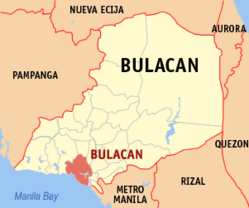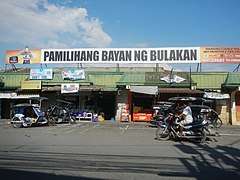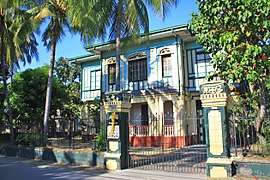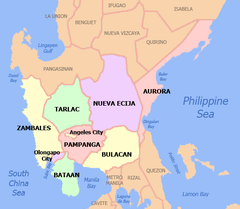Bulakan
Bulakan, officially the Municipality of Bulakan (Tagalog: Bayan ng Bulakan), is a 1st class municipality in the province of Bulacan, Philippines. According to the 2015 census, it has a population of 76,565 people.[3]
Bulakan Bulacan | |
|---|---|
| Municipality of Bulakan | |
 Poblacion | |
 Seal | |
| Nickname(s): First Capital of Bulacan | |
 Map of Bulacan with Bulakan highlighted | |
OpenStreetMap 
| |
.svg.png) Bulakan Location within the Philippines | |
| Coordinates: 14°47′34″N 120°52′44″E | |
| Country | |
| Region | Central Luzon (Region III) |
| Province | Bulacan |
| District | 1st District |
| Founded | 1572 |
| Barangays | 14 (see Barangays) |
| Government | |
| • Type | Sangguniang Bayan |
| • Mayor | Vergel C. Meneses |
| • Vice Mayor | Patrick Neil F. Meneses |
| • Congressman | Jose Antonio R. Sy-Alvarado |
| • Electorate | 48,530 voters (2019) |
| Area | |
| • Total | 72.90 km2 (28.15 sq mi) |
| Highest elevation | 30 m (100 ft) |
| Population (2015 census)[3] | |
| • Total | 76,565 |
| • Density | 1,100/km2 (2,700/sq mi) |
| • Households | 18,019 |
| Demonym(s) | Bulakeño |
| Economy | |
| • Income class | 1st municipal income class |
| • Poverty incidence | 6.17% (2015)[4] |
| • Revenue | |
| • Assets | |
| • Expenditure | |
| Utilities | |
| • Electricity | MERALCO |
| Time zone | UTC+8 (PST) |
| ZIP code | 3017 |
| PSGC | |
| IDD : area code | +63 (0)44 |
| Climate type | tropical monsoon climate |
| Native languages | Tagalog |
| Major religions | Roman Catholicism |
| Catholic diocese | Malolos |
It is 35 kilometres (22 mi) north of Manila.
Bulakan, which is one of the oldest towns in the Philippines, became the encomienda or capital of the Provincia de la Pampanga, and later became the first capital of the Province of Bulacan before it was moved to Malolos shortly after the American occupation.
With regards to whether to use the letters "c" or "k" to refer to the municipality of Bulakan, the New Provincial Administrative Code of Bulacan (Ordinance no. C-004) of 2007 states on Chapter 2, Section 15 that the word "Bulakan" stands for the municipality and first capital of the province while "Bulacan" refers to the province itself.[6]
The New Manila International Airport is being proposed to be built the coastlines of the municipality with target completion of 2025.
History
The name "Bulakan" is derived from the Tagalog word "bulak", which means "cotton". The town was named Bulacan due to the abundance of cotton plants growing in the region.
The Augustinians founded Bulakan as one of the visitas of Convento de Tondo in 1575 under its minister Fray Alonzo Alvarado, OSA. In 1578 it became a town Parish and Convent dedicated it under the patronage of Nuestra Señora de la Asunción with Caluya (now Balagtas, became town in 1599) and Guiguinto (became town in 1641) as its visitas.[7] According to local records, Father Agustin del Alburqueque, OSA is the first Prior of the Town.[8]
In a census of June 1591, the Province of Bulacan had 1,200 tributes or 4,800 persons, one Augustinian convent, one Gobernadorcillo and one alcalde mayor (present day governor) who had jurisdiction over the towns of Bulakan (then capital) Malolos, Calumpit, Guiguinto, Caluya and Meycauayan.
In the heart of the town stands the centuries-old adobe church of Our Lady of the Assumption (Nuestra Señora de la Asunción). In front of the church stands the municipal hall and a park named "Plaza del Pilar", which is dedicated to Revolutionary General Gregorio del Pilar who hailed from Barangay San Jose, Bulakan.
The Parish Church of Our Lady of the Assumption is the second oldest Roman Catholic church in the province and the longest and widest in terms of aisle length and span respectively. It has a baptismal book entry as early as 1578. On the first page of the book, written was the name of the barrio of the town of Bulacan, Bagio, Bulacan (Camino Real), Daan Estacion, Matungao, Cupang, Banban, Dapdap, Parian, Balubad, Pitpitan, Maysantor, Acsajo, Paniqui, San Nicolas, Nagdasig, Calungusan, Taliktik and Sta Ana.
After 400 long years, changes have been made to the old barrios that consist the town. Bagio became part of Bagumbayan in 1731, Tibig exist in 1735, Dapdap was renamed Santa Ana in 1741, Nagdasig become part of Tab-Ang in 1744 and now San Francisco, Parian was renamed Santa Inez in 1765, Bulacan (Camino Real), Daan Estacion, Paniqui and Calungusan was created into one barrio and was named San Jose, Barrio Pitpitan occupied Acsajo, Cupang was joined to Maysantor now Maysantol, Banban became Bangbang and now Bambang, Perez exists as separate barrio of Taliktik (now Taliptip), and with the same old name of barrios San Nicolas, Matungao and Balubad.
The early Bulaqueños, the residents of Bulakan, were engaged in farming, fishing and handicrafts, especially weaving.
The town of Bulakan, being the first capital of the province, gave the name to the province as customary to the other provinces of the early Philippines (like Cavite, Cavite; Tayabas, Tayabas (now Quezon Province) or Batangas, Batangas). It was the hub of economic activities and the inhabitants enjoyed excellent trade with Manila, primarily due to its proximity to the city and accessibility through its wide and navigable river.
Bulakan was also the scene of battle between the Spaniards led by Simón de Anda y Salazar and the British led by Captain Slay during the short British occupation of Manila. The British sent an expedition of 400 British, 300 Malabar Negroes and 2,000 Chinese allies. The Spaniards, with the natives of Bulacan, made a gallant stand but were defeated. Captain Slay eventually took over the town but did not last long.
A huge group of about 8,000 Filipino guerillas led by Spanish Jose Pedro de Busto made a nine long days battle in front of the church up to the foot bridge against Captain Slay. They made Captain Slay to retreat to Manila. On this fight, Bulaqueños have shown for the first time an extraordinary martyrdom. The British attempt of conquering the rest of the country was gone astray because of the marvelous fight made by Bulakeños.
The Church of Nuestra Señora de la Asuncion is the birthplace of Flores de Mayo, a feast for the Virgin Mary, held throughout the Philippines in the month of May. It is also the birthplace of the traditional song Dalit, a poetic chant for the patrons of a certain barrio or town. For centuries, the Church of the Our Lady of the Assumption served as the bastion of the Catholic faith all over the province. It served as the central church: a cathedral-like church serving as a primus inter pares among the Poblacion churches of Bulakan. After the erection of the Diocese of Malolos, its former glory slowly faded as the focus turned to the cathedral of the neighboring town Malolos: a church erected 2 years later in 1580. As the former capital of the secular rule, as well as the fortress of Christianity, it is due to give honor to this century-old church. Thus, the faithful along with the incumbent parish priest, Rev. Fr. Manuel Manicad, petitioned a request to the bishop, His Excellency Jose Francisco Oliveros, Bishop of Malolos, to declare the church as a Diocesan Shrine. Up until now, there is no response from the Diocesan Curia. The town still enjoys trade and commerce with the neighboring towns and Manila with whom she shares a coastline, a place that is replete with historical and glorious past.
Geography
The municipality of Bulakan lies in the southwestern part of the province of Bulacan and is surrounded by a number of municipalities. It is bounded on the north by the Municipality of Guiguinto, on the south by the Manila Bay, on the east by the Municipality of Bocaue, on the west by the City of Malolos, on the northeast by the Municipality of Balagtas, on the southwest by the City of Meycauayan and on the southeast by the Municipality of Obando.
It is about 35 kilometres (22 mi) away from the City of Manila. Approximately 72.90 square kilometres (28.15 sq mi) or 2.7284% of the total land area of the entire province. It ranks tenth (10th) in terms of land area among other municipalities in the province.
Barangays
Bulakan is politically subdivided into 14 barangays. Barangays San Jose and Bagumbayan are classified by the Philippine Statistics Authority as urban, with the rest as rural.
| PSGC | Barangay | Population | ±% p.a. | |||
|---|---|---|---|---|---|---|
| 2015[3] | 2010[9] | |||||
| 031405001 | Bagumbayan | 4.8% | 3,701 | 3,279 | 2.33% | |
| 031405002 | Balubad | 4.4% | 3,357 | 3,076 | 1.68% | |
| 031405003 | Bambang | 17.8% | 13,604 | 13,566 | 0.05% | |
| 031405004 | Matungao | 15.2% | 11,646 | 9,699 | 3.54% | |
| 031405005 | Maysantol | 3.6% | 2,768 | 2,712 | 0.39% | |
| 031405006 | Perez | 3.1% | 2,381 | 2,152 | 1.94% | |
| 031405007 | Pitpitan | 5.9% | 4,516 | 4,028 | 2.20% | |
| 031405009 | San Francisco | 8.0% | 6,145 | 5,221 | 3.15% | |
| 031405010 | San Jose (Poblacion) | 4.4% | 3,372 | 3,327 | 0.26% | |
| 031405012 | San Nicolas | 7.6% | 5,804 | 5,282 | 1.81% | |
| 031405013 | Santa Ana | 10.6% | 8,122 | 7,685 | 1.06% | |
| 031405014 | Santa Ines | 3.3% | 2,508 | 2,682 | −1.27% | |
| 031405015 | Taliptip | 7.2% | 5,490 | 6,202 | −2.30% | |
| 031405016 | Tibig | 4.1% | 3,151 | 2,840 | 2.00% | |
| Total | 76,565 | 71,751 | 1.24% | |||
Sitio Pariahan
The municipality was the location of Sitio Pariahan, a former insular community of more than a hundred families[10] who depended on fishing activity.[11] Considered as the largest sitio of Barangay Taliptip, it suffered land subsidence due to abusive use of groundwater,[11][12] and the resulting flow of the waters of Manila Bay displaced numerous residents.[12] Permanent inundation was ensured after rains brought forth by Typhoons Mina (internationally Nanmadol) and Ompong (internationally Mangkhut).[10] As of 2018 only 36 families remained living in the submerged sitio, whose official status has not yet revoked, and where remnants of a chapel and a school are still visible protruding out of the floods.[10] Bulakan municipal disaster risk reduction and management officer Rosario Mariano has expressed the urgency of permanent relocation for the residents of the sitio,[10] which is facing the threat of climate change.[12]
Climate
| Climate data for Bulakan, Bulacan | |||||||||||||
|---|---|---|---|---|---|---|---|---|---|---|---|---|---|
| Month | Jan | Feb | Mar | Apr | May | Jun | Jul | Aug | Sep | Oct | Nov | Dec | Year |
| Average high °C (°F) | 29 (84) |
30 (86) |
32 (90) |
34 (93) |
33 (91) |
31 (88) |
30 (86) |
29 (84) |
29 (84) |
30 (86) |
30 (86) |
29 (84) |
31 (87) |
| Average low °C (°F) | 20 (68) |
20 (68) |
21 (70) |
23 (73) |
24 (75) |
25 (77) |
24 (75) |
24 (75) |
24 (75) |
23 (73) |
22 (72) |
21 (70) |
23 (73) |
| Average precipitation mm (inches) | 7 (0.3) |
7 (0.3) |
9 (0.4) |
21 (0.8) |
101 (4.0) |
152 (6.0) |
188 (7.4) |
170 (6.7) |
159 (6.3) |
115 (4.5) |
47 (1.9) |
29 (1.1) |
1,005 (39.7) |
| Average rainy days | 3.3 | 3.5 | 11.1 | 8.1 | 18.9 | 23.5 | 26.4 | 25.5 | 24.5 | 19.6 | 10.4 | 6.4 | 181.2 |
| Source: Meteoblue [13] | |||||||||||||
Demographics
|
| ||||||||||||||||||||||||||||||||||||||||||||||||
| Source: Philippine Statistics Authority[3][9] | |||||||||||||||||||||||||||||||||||||||||||||||||
In the 2015 census, the population of Bulakan, was 76,565 people,[3] with a density of 1,100 inhabitants per square kilometre or 2,800 inhabitants per square mile.
In the 2010 census, the Municipality of Bulakan had a total population of 71,751. Barangay Bambang is the most densely populated with 13,566. It is followed by Barangay Matungao and Barangay Santa Ana with 9,699 and 7,685 respectively, on the other hand, the least populated barangay are Barangay Perez and Barangay Santa Ines with 2,152 and 2,682 respectively.[9]
Compared with the Municipality's population in 1995 which was 54,624, it shows an increase of 10,060 persons from 1995 to 2004. An annual growth rate of 1,117 or an average increase of 18.42% in the span of nine (9) years.
The highest percentage changes in population from 1995-2004 was exhibited in Barangay Perez, Pitpitan, Santa Ines, Tibig, Bagumbayan with an increase of 56.33%, 54.74%, 39.73%, 34.66%, and 33.46% respectively.
On the other hand, barangays that shows the least percentage change in population are Barangay San Francisco, Matungao, and Bambang with only an increase of 0.4%, 2.95% and 7.57% respectively.
Number of households
The Community Base Monitoring System (CBMS) survey as of January 2005 showed a total of 14,523 household. In comparison with the total number of household of 12,488 in 2002 an increase of 2,035 households from 2002-2005 is realized.
Gender and age structure
Like the rest of the country, the population in Bulakan exhibits a pyramidal age structure. The population between the age 0-14 accounts for 18,586 or 35% of the total population. On the other hand, 31,963 or 61% belongs to the 15–64 years old age bracket and only 2,103 or 4% are in the age bracket of 65 years old and above.
In terms of gender distribution the female population slightly out numbered the male population by .47% in 2002 Census on Population. There were 31,553 male population as against the 31,702 female population which results to gender ratio of 1 male is to 1.004 female comparatively.
Religion
The Roman Catholic, remained the dominant religion since its propagation in the town 1572. Out of the 64,684 total population in 2004, 56,436 or 87.25% were Roman Catholics. Other Christians faith that have found their way in the town are Members Church of God International more known as Ang Dating Daan, Iglesia ni Cristo, United Methodist Church, United Church of Christ in the Philippines, and many others.
Our Lady of Assumption Parish Church

The town's parish church, the Iglesia Parroquial de Nuestra Señora de la Asuncion, under the jurisdiction of the Roman Catholic Diocese of Malolos,[14] is one of the oldest and largest churches in the Bulacan Province. It is the site where Gregorio Del Pilar distributed the pamphlets made by his uncle, Marcelo H. Del Pilar who is a member of the Propaganda Movement. The National Historical Commission of the Philippines installed a historical marker in 2007 that declared the Bulakan Church as a Marked Historical Structure.
Language
Generally the town of Bulakan is a Tagalog speaking town. About 86.8% speak Tagalog while the rest speak Kapampangan.
Literacy rate
The 2005 Community Based Monitoring System Survey shows that the Population of 10 years old and above are around 38,164 persons and about 37,822 have a literacy rate of 99.10 percent.
The 2005 Community Based Monitoring System Survey also shows that there are only 219 licensed professionals here, the lowest in the whole province.
Local government
- Mayor: Vergel Meneses
- Vice Mayor: Patrick Neil Meneses
- Members of the Sangguniang Bayan:
- Alberto "Berting" Bituin
- Aaron Del Rosario
- Jun Felizardo
- Marilyn Fernando-San Pedro
- Jose Antonio "Tony" Lava
- Paul Lava
- Ma. Gloria "Oya" Mendoza-Neric
- Aika Sanchez
Education
Bulacan State University - Meneses Campus
Bulacan State University - Meneses Campus is a satellite campus of Bulacan State University, situated in Barangay Matungao.
Secondary Schools
Public high schools:
- Taliptip National High School
- Doña Candeleria Meneses Duque Memorial High School
- San Francisco Xavier High School
- Romeo Acuña Santos Memorial High School
Private high schools:
- Assumpta Academy
- Doña Trinidad Mendoza Institute
- Bulacan Montessori School
- Bulacan Methodist School
- Bulacan Central Christian School
Every barangay has its own day-care for pre-elementary pupils and an elementary school. There are also many private elementary schools situated in different barangays.
Notable people
- Marcelo H. Del Pilar - patriot, lawyer, journalist and activist, he was one of the leaders of the Propaganda Movement during the Spanish period and served as the second editor-in-chief of La Solidaridad; more known by his pseudonym "Plaridel", having him the origin of the name of the neighboring town Plaridel, Bulacan
- Gregorio Del Pilar - Katipunero nephew of Marcelo H. del Pilar, served as one of the youngest generals of the Philippine Revolution and the First Philippine Republic; known as the "Hero of Battle of Tirad Pass"
- Francisco Soc Rodrigo - lawyer, educator, broadcaster, journalist, playwright, and statesman having served as a member of the Senate of the Philippines from 1960-1972 and as a Commissioner on the 1986 Constitutional Commission. The "Gawad Soc Rodrigo" award was named after him by the Komisyon ng Wikang Filipino and National Commission for Culture and the Arts.
Gallery
- Bulakan Welcome Arch (from Guiguinto)
 Bulakan Wet and Dry Public Market
Bulakan Wet and Dry Public Market Francisco Soc Rodrigo Ancestral House
Francisco Soc Rodrigo Ancestral House Marcelo H. Del Pilar National Shrine
Marcelo H. Del Pilar National Shrine- Angkan ni Plaridel Mausoleum
 Museo Del Pilar
Museo Del Pilar
References
- "Municipality". Quezon City, Philippines: Department of the Interior and Local Government. Retrieved 31 May 2013.
- "Province: Bulacan". PSGC Interactive. Quezon City, Philippines: Philippine Statistics Authority. Retrieved 12 November 2016.
- Census of Population (2015). "Region III (Central Luzon)". Total Population by Province, City, Municipality and Barangay. PSA. Retrieved 20 June 2016.
- "PSA releases the 2015 Municipal and City Level Poverty Estimates". Quezon City, Philippines. Retrieved 1 January 2020.
- ""Commission on Audit 2017 Report-Bulacan"". Quezon City, Philippines: Commission on Audit. Retrieved 8 July 2018.
- "New Provincial Administrative Code of Bulacan" (PDF). Retrieved June 3, 2014.
- Administracion espiritual de los Padres Agustinos Calzados de la provincia del dulce Nombre de Jesus, by R. P. Fr. Fracisco Villacorta, Imprenta de H. Roldan Valladolid, Mayo 1833 p. 39
- Catalogo de los religiosos de N.P.S. Agustin de la Provincia del Smo Nombre de Jesus de Filipinas, Imp. De Ramirez Y Giraudier, Manila 1864. p. 11
- Census of Population and Housing (2010). "Region III (Central Luzon)". Total Population by Province, City, Municipality and Barangay. NSO. Retrieved 29 June 2016.
- Reyes-Estrope, Carmela (27 October 2018). "Pariahan, a community sent to extinction by climate". Philippine Daily Inquirer. Retrieved 22 September 2019.
- Severino, Howie (30 November 2018). "Ang Islang Walang Lupa". GMA News. Retrieved 22 September 2019.
- "Sinking feeling: Philippine cities facing 'slow-onset disaster'". Japan Times. Retrieved 22 September 2019.
- "Bulakan: Average Temperatures and Rainfall". Meteoblue. Retrieved 12 May 2020.
- Roman Catholic Diocese of Malolos
External links
| Wikimedia Commons has media related to Bulacan, Bulacan. |
